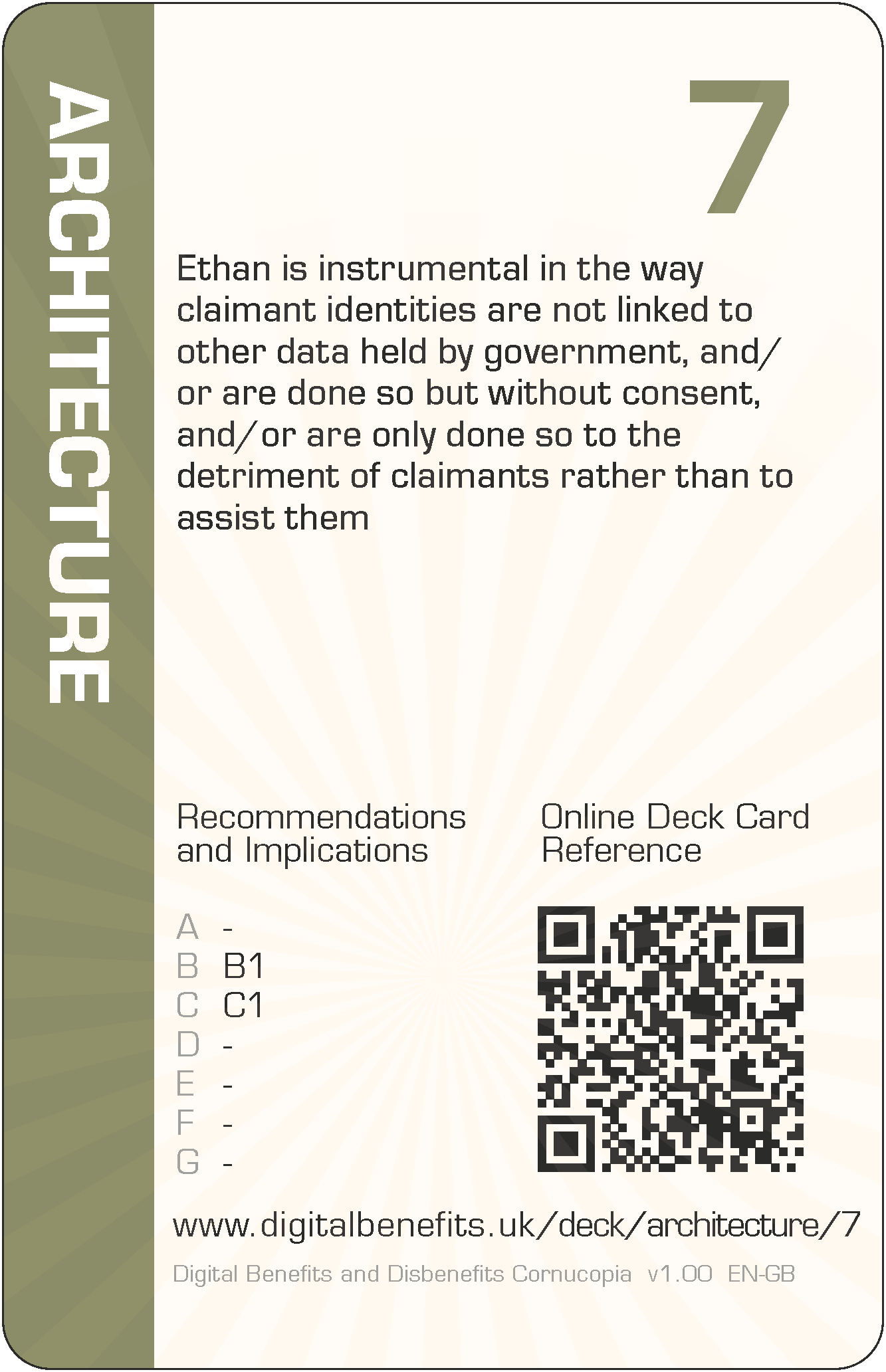Architecture 7 (AR-7) Card
DBD Cornucopia > Deck > Architecture > 7
Card Details - Seven of Architecture
Abbreviation
AR-7
Card's focus
The focus of this card is cross-linking government data
Threat to claimants
Ethan is instrumental in the way claimant identities are not linked to other data held by government, and/or are done so but without consent, and/or are only done so to the detriment of claimants rather than to assist them

Threat to claimants
Ethan is instrumental in the way claimant identities are not linked to other data held by government, and/or are done so but without consent, and/or are only done so to the detriment of claimants rather than to assist them.
Some examples of how this threat could lead to harms (negative effects on claimants)
The design recommendations and implications relevant to the card are listed below in the next section, but even those can be somewhat abstract and difficult to think about during practical day-to-day implementation. Therefore, some example harms are provided to complement the more formal research outputs. These examples are unique per card, and are only published on these web pages (i.e. in no other project outputs).
- Claimants are not asked before sensitive information from another government department is used, leaving them feeling side-lined
- Information already held, and which would help a claimant make an accurate and/or successful claim, is not offered, causing them extra work or to submit a less complete claim
- By claiming, claimants lose a greater amount of money from a different award, making them worse off
The examples are to help understand the threat on the card, not to suppress thinking and innovation. Incorporating these examples exactly, or closely matching ones, should be scored down when playing DBD Cornucopia as a game.
Applicable design recommendations and implications
These are reproduced here from Research Briefing N
Acknowledge claimants as people in digital design
- Prioritise claimants' interests over system efficiencies
All digital welfare design processes, methods and decision-making should prioritise claimants' needs to achieve best outcomes for individuals rather than system efficiencies. Organisational knowledge and resources should be utilised to this respect including intervening in advance to identify matters that affect claims or what claimants may have forgotten about.
Reduce claimants’ interaction burdens with digital welfare
- Shift the burden of gathering evidence from claimants towards the state
Transfer effort from claimants to the state, to improve timeliness and reliability. Prioritise the implementation of dig- ital processes to gather or import, check and use necessary data from internal and external providers. Change claimants' role to verifying the data, rather than providing it, and ensure claimants have visibility and control over derived status attributes.
General Notes
Card values (i.e. '7' for this card) are for game play and are not correlated with the severity of harm. This is because threats cannot be ranked directly since they can affect individuals in different ways due to situations and circumstances, or affect fewer or more claimants, or the harms can arise in claimants' support networks and wider society.
The threat description uses a person's name as the "attacker" (i.e. 'Ethan' for this card), which can be thought of someone involved with implementation. They could have any role which influence digitisation. So they could be a database administrator, or a copy writer, or a quality assurance specialist, etc, or all of these. Everyone could have some influence on the claimant threat described. The names were randomly selected from those currently most popular as given names for boys and girls (UK Office for National Statistics).
The example harms provided are drawn from the research data (which explored not only parts of existing services but also the effects of possible changes to those), from the author's own knowledge of web application development and testing, the author's own experience of helping citizens to claim Universal Credit (UC) and Personal Independence Payment (PIP), and from suggestions submitted by other people (make a suggestion). The threats and example harms do not necessarily exist in the current UC or PIP deployments or in ecosystems around those services, but they might well do.
All the cards in this Architecture suit are: 2 3 4 5 6 7 8 9 10 J Q K A
The other suits in the deck are: Scope, Agency, Trust, Porosity and Cornucopia (plus Jokers).
